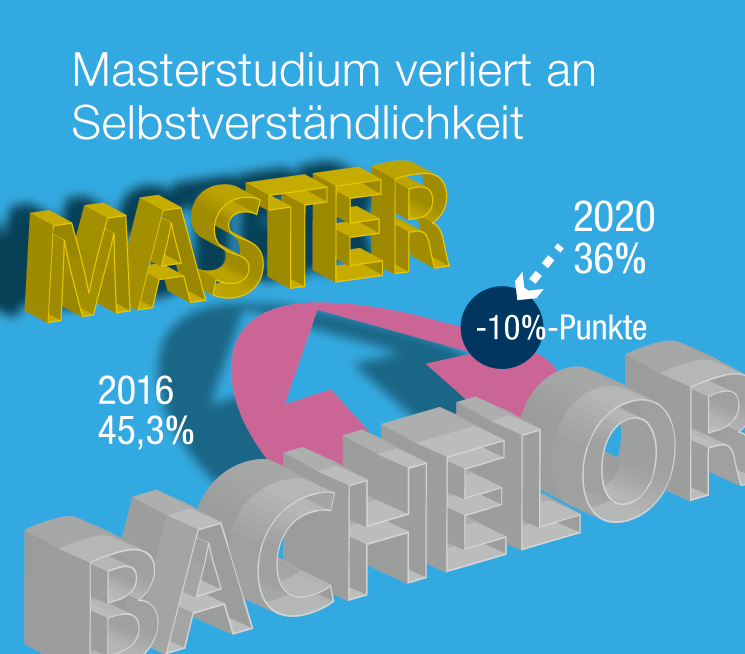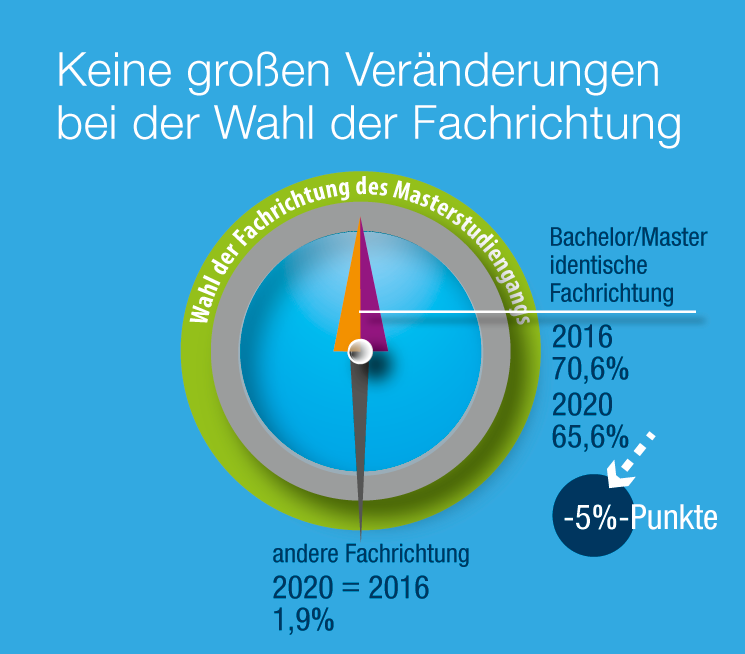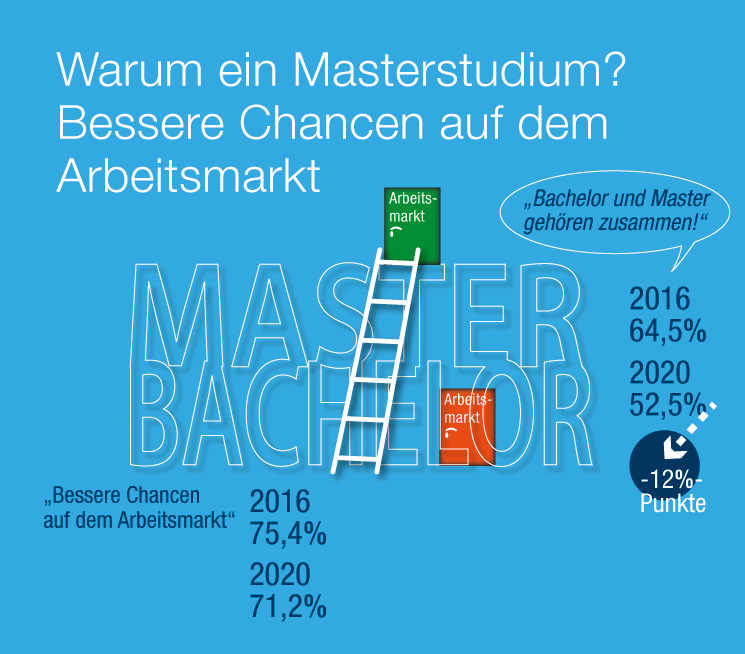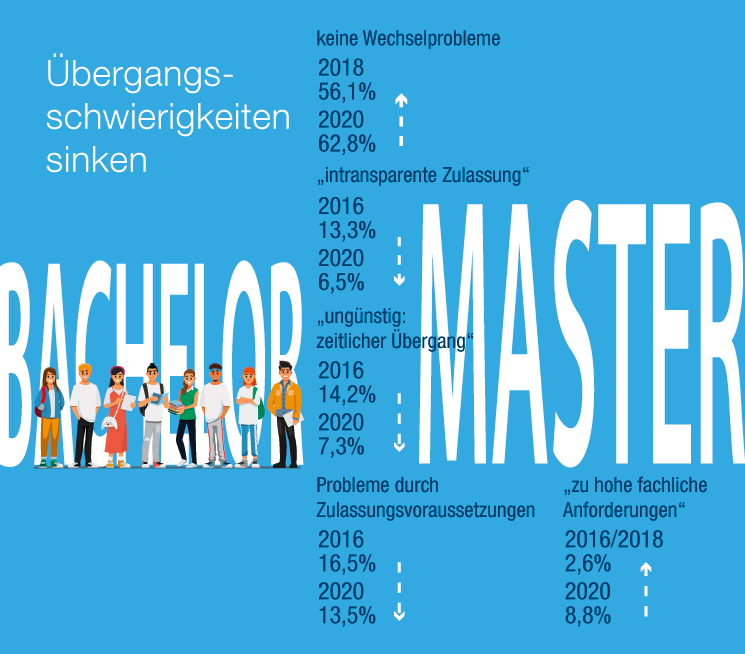(No) change from Bachelor’s to Master’s degree programme? – FAU-St in pictures
The results of the student survey over the last few years – Part 4
499 of the respondents of the 2020 FAU-St survey started their Master’s degree programme in winter semester 2019/20 or summer semester 2020. In this, the final article from our series about FAU-St in pictures, we take a closer look at their responses to find out if, when and why they decided to study for a Master’s degree and if this meant a change of subject.
The entire report containing the findings of previous FAU-St surveys is available on the OPUS publication and document server.

Master’s degree is less of a matter of course
Only around 36 percent of the respondents in 2020 already knew before they started their Bachelor’s degree programme that they would study for a Master’s degree afterwards. This result is down by around 10 percentage points compared with 2016, where 45.3 percent of respondents indicated they were planning on taking a Master’s degree.
The changes in responses during this time from students who decided to study for a Master’s degree during, towards the end of or after completing their Bachelor’s degree were less noticeable, with variations of just between two and four percentage points.

No significant changes in choice of subject
There have hardly been any changes to the choice of subject for the Master’s degree programme over the last few years. In 2020, only 1.9 percent of respondents chose a completely different subject from their Bachelor’s degree programme, just like in 2016. There were some slight variations during the last few years in the number of respondents who chose to specialise during their Master’s degree (12 percent in 2016 compared to 12.6 percent in 2020) or those who chose a related subject (13 percent in 2016 compared to 15.6 percent in 2020).
The proportion of students who chose the same subject as for their Bachelor’s degree fell by 5 percentage points from 70.6 percent in 2016 to 65.6 percent in 2020.

Why study for a Master’s degree? One reason is better opportunities on the job market.
As mentioned above, fewer respondents seem to believe that a Bachelor’s degree ought to be followed by a Master’s degree. In 2020, only 52.5 percent said that they believed Bachelor’s and Master’s degrees belong together. This is compared to 64.5 percent who held this view in 2016. In 2020, 71.2 percent of respondents said that having a Master’s degree improves your chances on the job market. However, in 2016 a slightly larger number of respondents believed this was the case (75.4 percent).
The results of the survey also indicate that doctoral degrees have been becoming slightly more important since 2016, when 30.4 percent of respondents said they wanted to study for a doctoral degree. In 2020, this rose to 34 percent. Academic interest in a subject seems to motivate more respondents in 2020 to complete a Master’s degree than in 2016 (a rise from 56.4 percent to 60.6 percent).

Fewer problems with the transition
We discovered that more than half of all respondents studying for a Master’s degree did not have any problems with the transition from a Bachelor’s degree to a Master’s degree (62.8 percent in 2020; 56.1 percent in 2018).
Some stumbling blocks have been removed. For example, the application and admission procedures were perceived by only 6.5 percent of respondents as lacking transparency in 2020, which is a fall of 6.8 percentage points compared with 2016. A similar trend can be seen in the timing of the transition between the two degrees. In 2016, 14.2 percent thought the timing was unfavourable, but in 2020, only 7.3 percent of respondents thought this was the case.
Fulfilling the admission requirements is a problem for only 13.5 percent of respondents in 2020. This was 16.5 percent in 2016.
On the other hand, nearly nine percent of the respondents in 2020 said that the subject’s requirements are too high. In 2016 and 2018, only 2.6 percent thought so.

Every year, students at FAU have the opportunity to evaluate their study situation and the services provided by the University during the FAU-St student survey. Due to the coronavirus pandemic, students were also asked to evaluate online teaching during last year’s survey. We will now use the data from 2016 to 2020 to prepare graphics of the results during the next few weeks.
- Here is the first part: How satisfied are FAU students? – FAU-St in pictures
- Here is the second part: First experiences of university life – FAU-St in pictures
- Here is the third part: How is your degree going? – FAU-St in pictures
The entire report of previous FAU-St surveys is available on the OPUS publication and document server.
